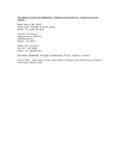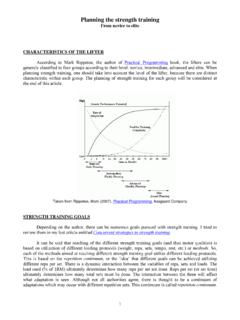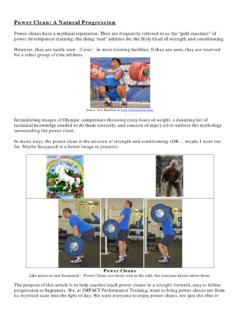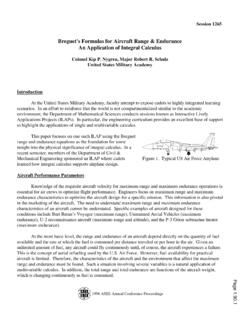Transcription of PreSeason Training for Basketball: Preparing the athlete ...
1 Pre-Season Training for Basketball: Preparing the athlete for the demands of the season. Glenn Harris, MS, CSCS Head Coach, Strength & Conditioning Boston University Athletics Contact Information: Department of Athletics 285 Babcock St. Boston, MA 02215 Office: 617-353-6454 Fax: 617-353-5286 Email: Keywords: Basketball, Strength, Conditioning, Tempo, Volume, Intensity Author s Bio: Glenn Harris is the Head Coach of Strength and Conditioning at Boston University in Boston, MA. Basketball is a fast paced game. Up and down action on the court, defensive positioning down low under the basket combined with pure hustle for loose balls on the floor make the sport of basketball one of the most exciting sports to watch.
2 For the strength and conditioning coach working with basketball players, the responsibility of designing a program that will make them better athletes for their sport is rewarding. Flexibility, conditioning, speed, quickness and agility along with strength and power are the areas of emphasis when designing the Boston University Basketball strength and conditioning program. Training for basketball is a year long commitment. I define our Training year, beginning in the summer as the off season component to the year. The Training year will then go into the pre-season, which will encompass approximately six weeks of Training from the beginning of the school year until the start of formal practices.
3 The in-season takes place from the first day of practice until the last game in March. Finally, the post-season occurs from the end of the season until the end of the school semester, usually ending the first week of May. Each component to the Training year carries a high level of importance. For the purposes of this article, our pre-season program will be the point of focus. The pre-season Training period commences at the start of September and will continue until the middle of October. This phase will typically last six weeks, fluctuating occasionally due to changes in the start time of the school semester and the start time of the first official practice which occurs in the middle of October.
4 Objectives Prior to beginning the pre-season, it is important to list the objectives that are to be accomplished during this phase. Once the objectives have been listed, it becomes easier to outline and design a program that is specific to the task at hand. The objectives for the pre season program are: Prepare the team for the practice volume Improve sport specific speed and conditioning. Improve flexibility. Improve core strength. Improve total body strength and power. Knowing the objectives, the strength and conditioning coach can now begin the program design process. Addressing each of these objectives with a periodized approach to progression, while implementing functional exercises, will help the athletes reach the level of in-season fitness needed for the beginning of practice.
5 Warm-up & Stretch Each workout will begin with a dynamic warm-up. The intent of the warm-up is to gradually increase the athlete s body temperature and increase their kinesthetic awareness. The warm-up will vary daily to help ensure that the athletes are enthusiastic about doing something new for the day. During the five scheduled sessions for the week, the team will participate in one of three warm-ups: Continuous (Table 1), Agility Ladder (Table 2), Hurdle Mobility (Table 3). Following the warm-up routine for the day, the team will then do a stretching routine (Table 4). An important area of focus when working with basketball players is the attempt to improve overall flexibility.
6 It is important to note that improving flexibility is a year long process not isolated to a particular cycle of the Training year. Table 1. Continuous Warm-Up 2 x 20yd ea. High Knee Walk High Knee Skip High Knee Run Butt Kicks Straight Leg Walk Backwards Skip Backwards Run Carioca Defensive Slide Table 2. Agility Ladder Warm-up In-In / Out-Out: Fwd & Bkwd Left & Right Cross-over Front: Fwd & Bkwd Cross-over Behind: Fwd & Bkwd Can-opener: Front Leg In Back Leg In Shuffle Fwd & Bkwd Scissors Left & Right Hop Scotch Fwd & Bkwd Table 3.
7 Hurdle Mobility Forward Right leg lead Left leg lead Lateral Right leg lead Left leg lead Backward Right leg lead Left leg lead Hurdle Mobility Table 4. Stretching Routine Each movement done for 10 repetitions Or stretch is held for 10 15 seconds Arm Circles Thumbs up and forward Thumbs down and backward Standing Trunk Rotation Right and Left Leg Swings Forward & Backward Side to side Standing V Stretch Down to the Right, Left, & Middle Seated V Stretch Down to the Right, Left & Middle Seated Right Leg In (Pulling the knee to the chest) Seated Left Leg In (Pulling the knee to the chest)
8 Lying Piriformis Stretch Right and Left Lying Trunk Twist Feet flat on the floor and knees bent 90* Butterfly Groin Stretch Gastroc Stretch Right and Left Standing Hip Flexor Right and Left Conditioning Although there will be individual workouts and pick-up games during the pre-season, there will also be three days of conditioning during the week. Conditioning will occur on Monday, Wednesday and Friday on an Airdyne Stationary Bike. Conditioning on Monday and Friday will be interval based and will be done before the strength Training workout. Wednesday s workout will only be conditioning involving a longer steady state workout.
9 Monday and Friday s bike intervals (Table 5) will be performed using the Tabata principle. A Tabata workout consists of 20 seconds of maximum intensity exercise, followed by 10 seconds of rest, repeated without pause 8 times for a total of four minutes. Dr. Izumi Tabata and a team of researchers from the National Institute of Fitness and Sports in Tokyo, Japan conducted the groundbreaking 1996 study, published in Medicine and Science in Sports & Exercise. The Tabata bike workouts are specific to basketball. Basketball is an interval based sport with quick bursts of sprints and stops. Also, a Division I college basketball game is broken down into approximately 4 minute segments due to media timeouts.
10 Therefore, we have built on the original Tabata principle and performed multiple 4 minute bike workouts over the course of the pre-season. In the attempt to increase the carryover effect of Training from the weight room to the basketball court, each 4 minute set is separated with a 2 minute rest period, similar to the media timeout during games. Table 5. Tabata Bike Intervals :20 seconds HARD / :10 seconds Rest 2 Minutes Rest between sets Wk1 Wk2 Wk3 Wk4 Wk5 Wk6 Monday 1x8 2x8 3x8 4x8 Rest Friday 1x8 2x8 2x8 3x8 4x8 Week Wednesday s bike workout is focused on a steady state effort.











